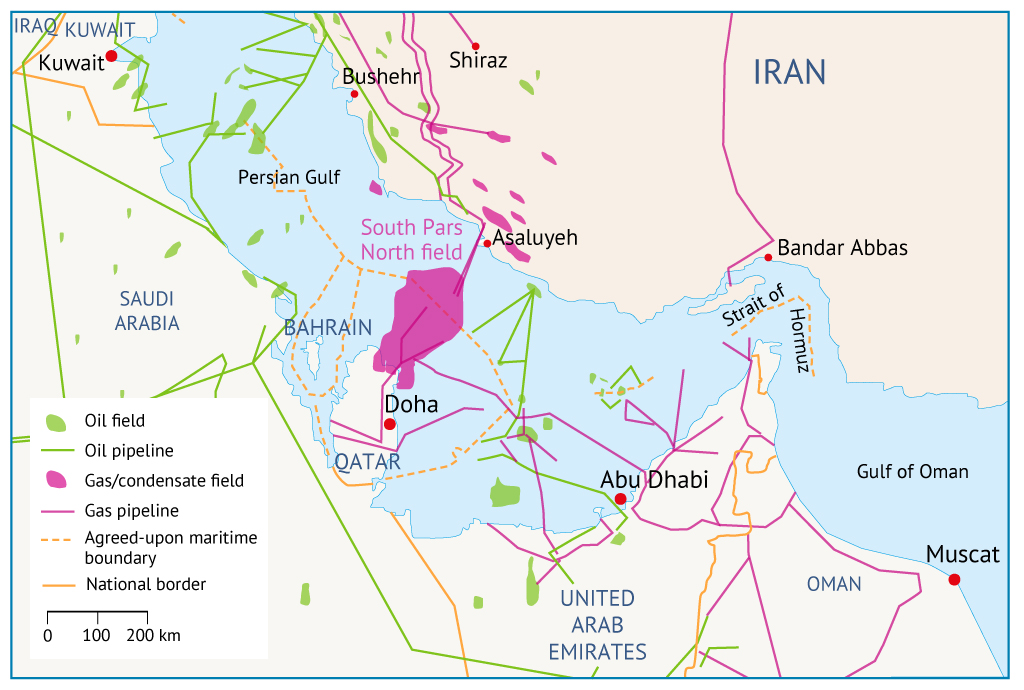
Downstream oil sector
There is an extensive domestic network to take the crude to export terminals and refineries. However, Iran’s gas export capacity is relatively trivial. Crude oil is exported via Persian Gulf island terminals to tankers that pass through the Strait of Hormuz.
Oil export terminals
The Kharg, Lavan and Sirri Islands, located in the Persian Gulf, handle almost all of Iran’s crude oil exports.
(1) Kharg Island: The largest and main export terminal in Iran accounts for roughly 90% of Iran’s exports. Kharg’s loading system has a capacity of 5mbbl/d. The terminal processes all onshore production (the Iranian Heavy and Iranian Light Blends) and offshore production from the Forouzan field (the Forouzan Blend). Its storage capacity was expected to increase to 28 million barrels of oil in 2014. Kharg Island was the focus of attack by Saddam’s air force in the so-called Tanker Wars during the Iran-Iraq war.
(2) Lavan Island: Bearing the name of the offshore fields, the terminal handles exports of the Lavan Blend (light sweet). Lavan facilities have the capacity to process 200,000bbl/d of crude oil. Lavan has a two-berth jetty, which can accommodate vessels up to 250,000 deadweight tons. Lavan’s storage capacity is 5.5 million barrels.
(3) Sirri Island: The Sirri terminal processes crude from the Sirri offshore field complex, and includes a loading platform equipped with four loading arms that can load tankers from 80,000 to 330,000 deadweight tons. Its storage capacity is 4.5 million barrels.
In addition to crude oil, Iran also exports petroleum products. According to FGE, Iran exported about 240,000bbl/d of petroleum products in 2013, most of which was fuel oil and liquefied petroleum gas (LPG) sent to Asian markets. Iran’s petroleum product exports declined by roughly 40% in 2013 compared with the 2011 level – indicative of the adverse effects of sanctions.
The export terminals Bandar Mahshahr and Abadan (also known as Bandar Imam Khomeini), are near the Abadan refinery (Iran’s second largest) and are used to export refined products from the Abadan refinery. Bandar Abbas, located near the northern end of the Strait of Hormuz, is Iran’s main fuel oil export terminal. Condensate from the South Pars natural gas field is exported from the Assaluyeh terminal.
The Strait of Hormuz is the world’s most important oil chokepoint because of its daily oil flow of 17 million barrels (average in 2013), constituting about 30% of all seaborne-traded oil. The vast majority of Iran’s exports flow through this route. Iran has a hand in controlling the strait, which at its narrowest point is 34km wide. This has led many to be wary of the supply security risks and is likely a prominent factor in the presence of the US 5th fleet in the surrounding waters.
Refinery capacity and domestic consumption
Iran is the second-largest oil-consuming country in the Middle East, after Saudi Arabia. Iranian domestic oil consumption is mainly diesel, gasoline and fuel oil. Total oil consumption averaged approximately 1.75mbbl/d in 2013. As of September 2013, Iran’s total crude oil distillation capacity was nearly 2.0mbbl/d, about 140,000mbbl/d more than the previous year, according to FGE (see table below). Most of that increase came from expansion projects that were recently completed at the Arak and Lavan refineries.
The downstream sector is run by the National Iranian Oil Products Refining and Distribution Company (NIOPRDC). The nine refineries, at Abadan, Arak (Shazand), Bandar Abbas, Isfahan, Kermanshah, Lavan, Shiraz, Tabriz and Tehran, have a combined crude oil throughput capacity of 1.7mbbl/d under optimal conditions.
Iran also extracts petroleum products (naphtha and LPG) at natural gas processing plants. A small amount of crude oil, approximately 4,000bbl/d, is directly burned for power generation. In refinery capacity too, the effects of sanctions have put Iran in the highly perverse position of being the second-largest oil reserve holder on the planet and yet it imports petroleum products. In 2013, FGE estimated that Iran imported almost 17,000bbl/d of petroleum products, of which roughly 85% was gasoline. Over the past several years, however, Iran’s gasoline import dependence has decreased significantly as a result of increased domestic refining capacity and subsidy cuts. Iran planned to increase gasoline production capacity at the Isfahan and Bandar Abbas refineries by the end of 2014.
Iran’s energy prices, particularly gasoline prices, are heavily subsidized. At the end of 2010, the government initiated the first phase of subsidy reform, decreasing subsidies on energy prices to discourage waste. The second phase of this reform was initiated in early 2014. According to FGE, gasoline prices have risen by 43% to 75%. As a result, gasoline consumption is expected to decline in the near term, cutting imports.

